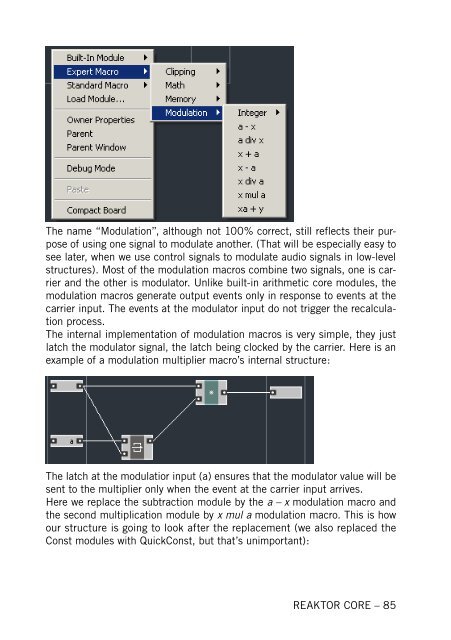1. First steps in Reaktor Core - Native Instruments
1. First steps in Reaktor Core - Native Instruments
1. First steps in Reaktor Core - Native Instruments
Create successful ePaper yourself
Turn your PDF publications into a flip-book with our unique Google optimized e-Paper software.
The name “Modulation”, although not 100% correct, still reflects their purpose<br />
of us<strong>in</strong>g one signal to modulate another. (That will be especially easy to<br />
see later, when we use control signals to modulate audio signals <strong>in</strong> low-level<br />
structures). Most of the modulation macros comb<strong>in</strong>e two signals, one is carrier<br />
and the other is modulator. Unlike built-<strong>in</strong> arithmetic core modules, the<br />
modulation macros generate output events only <strong>in</strong> response to events at the<br />
carrier <strong>in</strong>put. The events at the modulator <strong>in</strong>put do not trigger the recalculation<br />
process.<br />
The <strong>in</strong>ternal implementation of modulation macros is very simple, they just<br />
latch the modulator signal, the latch be<strong>in</strong>g clocked by the carrier. Here is an<br />
example of a modulation multiplier macro’s <strong>in</strong>ternal structure:<br />
The latch at the modulatior <strong>in</strong>put (a) ensures that the modulator value will be<br />
sent to the multiplier only when the event at the carrier <strong>in</strong>put arrives.<br />
Here we replace the subtraction module by the a – x modulation macro and<br />
the second multiplication module by x mul a modulation macro. This is how<br />
our structure is go<strong>in</strong>g to look after the replacement (we also replaced the<br />
Const modules with QuickConst, but that’s unimportant):<br />
REAKTOR CORE – 85










